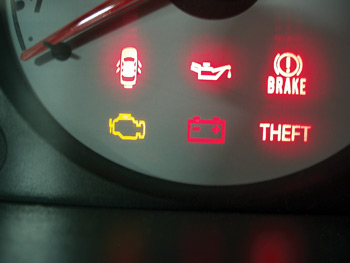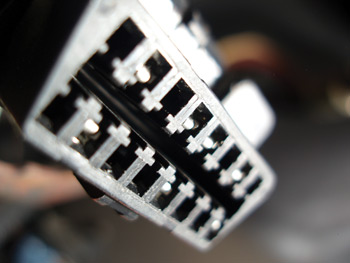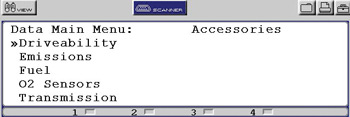During the 1980s, on-board diagnostics were introduced on import vehicles to help diagnose intermittent failures in vehicle electronics. Most of these on-board diagnostic (OBD) or OBD I systems were dedicated to detecting about 30-50 fault-code emissions failures in their engine management systems. See Photo 1. 
Beginning in 1996, federally-mandated OBD II systems were introduced that doubled the computing capacity of earlier OBD I computers. Because the on-board diagnostics were more comprehensive and detailed, auto manufacturers began to add body control, anti-lock braking, vehicle security, vehicle stability and other modules. The DTC count went from approximately 40 in OBD I systems to hundreds and even thousands in modern OBD II systems. On-board computer and module counts went from the single engine control module of the 1980s, to as many as 70 on-board modules built into the high-end platforms sold during the 2010 model year. See Photo 2.
THE MODERN MARKET
The current MIL diagnostics market has become as complex as the systems we’re now servicing. Because all systems, such as engine management, powertrain management, anti-lock braking, air bag, vehicle security and vehicle stability control must share information, all of the various modules are networked together by a number of bus communications systems that function at various speeds and priorities. See Photo 3.
Unfortunately, the general public isn’t aware of the complexities in modern vehicle platforms and neither are many shop owners, managers and service writers. Many still believe that diagnostics is an intuitive, “lucky guess” process that requires little in education and equipment. With this history in mind, let’s look at the issues posed by modern vehicle diagnostics.
REPROGRAMMING ISSUES
Because modern import vehicles contain more replacement modules that must be configured to the vehicle’s on-board electronics systems, more shops are beginning to discover that their current diagnostic equipment won’t perform this vital repair function. Shop owners can choose between investing in an aftermarket J-2534 flash reprogramming system, or an OEM or “factory” scan tool or diagnostic system.
Because it’s not possible in this space to cover in depth the many issues involved, I recommend that shop owners and technicians consult the National Automotive Service Task Force (NASTF) website www.nastf.org to help make their tooling decisions. Keep in mind that the J-2534 and OEM equipment require reliable high-speed Internet connections to download calibrations and service information from OEM websites. In addition, aftermarket J-2534 reprogramming tools usually require a dedicated laptop computer and other equipment to permit downloads.
On the flip side, many shop owners are investing in the OEM diagnostic systems. I use the word “systems” because much of this equipment is PC-based and is linked directly to the OEM’s website.
On the upside, an OEM connection will provide full access to factory information and to the latest calibration downloads.
On the downside, the initial cost might range from about $4,000, to as much as $8,000 for many popular nameplates.
Annual subscription fees ranging from a few hundred to several thousand dollars might also be required to support access to OEM service information.
The reprogramming issue is at the forefront of the current diagnostic dialogue, so it’s time to start thinking about acquiring reprogramming capability that will fit your current and future needs.
SCAN TOOLS
Some shops are meeting their current diagnostic challenges by using several OEM diagnostic systems to serve their core nameplates and then using several aftermarket scan tools to fill out the remainder of their general service needs. Even if you’ve invested in an OEM diagnostic system, most of the routine diagnostic functions in your shop can be performed by an aftermarket scan tool.
Here again, there are a variety of aftermarket scan tools available that serve a general market and many that serve a specialized market like Asian or European. Some of these specialized scan tools might also have a limited reprogramming capability. And, here again, it’s important to choose a scan tool that will serve the majority of your shop’s workflow.
BILLING DIAGNOSTICS
Back in the day, many dealership and independent shops either didn’t charge for diagnostics or charged a token rate for troubleshooting difficult problems. That strategy simply won’t work in today’s service market because the learning curve is much steeper and longer, and because the equipment cost and subscription fees are much higher. (For more on charging for diagnostic service, see Mitch’s World beginning on page 36.) And, depending upon the application, modern diagnostic equipment will average about four to five years of use before it becomes obsolete or is replaced by a more modern version.
In short, each addition of diagnostic equipment adds another layer of overhead to any shop operation. One method of estimating this layer of overhead would be to divide the cost of the equipment and its annual subscriptions by a 48-month effective service life. If the equipment costs $8,000 and the subscription fees amounted to $6,000, the total outlay would be $14,000 over 48 months. The average monthly cost for equipment (and subscription fees) would be about $291.67 per month if the $14,000 outlay were divided by 48 months.
Dividing the $291.67 by the number of labor hours billed each month will yield the increase in hourly rate needed to support this equipment. If the cost of the diagnostic equipment is added to a shop’s hourly rate, it will pay for itself. If it’s left as a stand-alone expense, it will appear on the books as a liability. But, if the equipment increases a shop’s productivity and efficiency, it will generate a good profit.
PRICING DIAGNOSTIC SERVICES
At the outset, let me say that many pricing strategies exist in our current diagnostic market. At its most basic level, diagnostics should yield the same hourly profit as any conventional service that produces profit from labor and parts sales.
Some shops operate on a matrix billing system in which the hourly rate is determined by the technicians’ skill level, level of difficulty and the potential liabilities involved. Engine repair would, because of its inherent liability issues, be priced much higher than, let’s say, an exhaust replacement. For that reason, some shops price diagnostics at double their hourly base rate. Other shops menu-price each step in the diagnostic process such as fuel pressure testing, diagnostic code retrieval, etc.
When pricing diagnostic services, remember that diagnostic times used in dealership operations are based on a high degree of familiarity with the vehicle platform and its diagnostic issues. Obviously, the more a shop specializes in a specific nameplate, the more familiar it becomes with the diagnostic issues of those vehicles and the less it spends on diagnostic equipment and website subscriptions. Unfortunately, general repair shops don’t enjoy that advantage, so each shop must tailor its diagnostic billing procedures to its specific clientele and workflow.
DIAGNOSTIC STRATEGIES
Many shop operators tend to underestimate the skills and knowledge required to diagnose complex electronic problems. To put the issue in perspective, the majority of code-based electronics failures are pattern failures and are relatively simple to solve. The easiest problems to solve are the pattern failures unique to a specific nameplate and platform. “Hard” failures are also relatively easy to solve because they can be duplicated in the repair shop. For these reasons, most pattern and hard-failure conditions can be priced on a menu-driven basis. Most would require a minimum diagnostic fee to retrieve DTCs and an hourly estimate to replace the defective part.
On the other hand, intermittent and random failures can be very difficult to solve. Intermittent failures can be described as those that occur on a regular basis or under specific driving conditions. Random failures are those that seem to occur on irregular or unpredictable set of driving conditions. Intermittent and random failures generally require retrieving DTCs, researching TSBs and performing a physical exam to “baseline” the integrity of the vehicle’s mechanical, fuel delivery, electronic and electrical systems.
Many shops price this work by the diagnostic hour, which is at least 1.5 or 2.0 times the shop’s basic hourly labor rate. However you choose to approach the issue, it’s important to start establishing profitability in MIL diagnostics.












